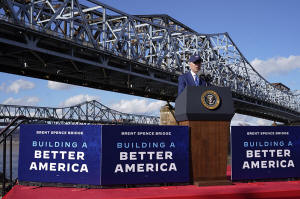US infrastructure improved with Biden-era spending but there's a long
way to go
[March 25, 2025] By
TAMMY WEBBER and MICHAEL PHILLIS
A once-every-four-years report card on the upkeep of America's
infrastructure gave it a “C” grade on Tuesday, up slightly from previous
reports, largely due to investments made during former President Joe
Biden's administration.
The report from the American Society of Civil Engineers, which examined
everything from roads and dams to drinking water and railroads, warns
that federal funding must be sustained or increased to avoid further
deterioration and escalating costs.
“We have seen the investments start to pay off, but we still have a lot
of work to do out there,” said Darren Olson, chair of this year’s
report. He said decrepit infrastructure – from poor roads that damage
cars to delayed flights to power outages that spoil groceries — hurts
people and the economy.
“By investing in our infrastructure, we’re making our economy more
efficient, we’re making it stronger (and) we’re making ourselves
globally more competitive,” he said.
It’s especially critical that infrastructure can handle more extreme
weather due to climate change, said Olson, noting hurricanes that
devastated the East Coast and parts of Appalachia last year. The U.S.
saw 27 weather disasters last year that cost at least $1 billion,
second-most since 1980.
The 2021 Infrastructure Investment and Jobs Act provided $550 billion in
new infrastructure investments, but is set to expire in 2026. Another
$30 billion came from the 2022 Inflation Reduction Act, including for
projects focused on clean energy and climate change, the engineering
group said.

President Donald Trump's administration has targeted some of Biden’s
green policies. Public parks improved to a C-minus from a D-plus, for
example, thanks in part to significant investments over several years.
Recently, however, the Trump administration moved to slash National Park
Service staffing.
In 2021, the U.S. earned a C-minus overall. The investments made since
then are just a fraction of the $9.1 trillion that the civil engineers
group estimates is needed to bring all of the nation’s current
infrastructure into a state of good repair.
Even if current federal infrastructure funding were maintained, there
still would be a $3.7 trillion gap over a decade, according to the
report.
The bill to upgrade and maintain the nation’s roughly 50,000 water
utilities, for example, is $625 billion over the next two decades,
according to the federal government. The grade for drinking water was
C-minus, unchanged from four years ago.
Many communities already struggling to maintain old, outdated drinking
water systems also face new requirements to replace lead service line s
and reduce per- and polyfluoroalkyl substances, collectively known as
PFAS.
The infrastructure bill helped complete or start “a lot of really
important projects,” said Scott Berry, director of policy and
governmental affairs at the US Water Alliance. “But the gap has widened
so much over the last couple of decades that a lot, lot more investment
is going to be needed.”
The bill also provided billions to help the U.S. Army Corps of Engineers
upgrade inland waterways, which move roughly $150 billion in commerce
every year, improving the grade from a D-plus to a C-minus.
[to top of second column] |

President Joe Biden speaks about his infrastructure agenda
under the Clay Wade Bailey Bridge, Jan. 4, 2023, in Covington, Ky.
(AP Photo/Patrick Semansky, File)
 Barges on the Mississippi River, for
example, carry enormous amounts of coal, soybeans, corn and other
raw materials to international markets. But critical infrastructure
like locks and dams — many built more than a half-century ago and
requiring regular maintenance and repair — is often invisible to the
public, making it easy to neglect, said Mike Steenhoek, executive
director of the Soy Transportation Coalition.
And when big projects are funded, it too often comes in stages, he
said. That forces projects to pause until more money is
appropriated, driving up costs for materials and labor.
“If we really want to make the taxpayer dollars stretch further, you
have got to be able to bring a greater degree of predictability and
reliability in how you fund these projects,” he said.
The report's focus on engineering and money misses the importance of
adopting policies that could improve how people use and pay for
infrastructure, according to Clifford Winston, a microeconomist in
the Brookings Institution’s economic studies program.
“You fail to make the most efficient use of what you have,” said
Winston. For example, he noted that congestion pricing like that
recently adopted by New York City — charging people to drive in
crowded areas — places the burden on frequent users and can pressure
people to drive less, reducing the need for new bridges, tunnels and
repairs.
Roads remain in chronically poor shape, receiving a D-plus compared
to a D in the last report, despite $591 billion in investments since
2021.
Two categories, rail and energy, received lower grades. Disasters
like the derailment of a train carrying dangerous chemicals in East
Palestine, Ohio, in 2023 lowered rail’s previous B mark to a
B-minus.
The energy sector, stressed by surging demand from data centers and
electric vehicles, got a D-plus, down from C-minus.

Engineers say problems in many sectors have festered for so long
that the nation must figure out how to address the shortcomings now
or pay for them when systems fail.
On Wednesday, a delegation of engineers will visit Washington to
talk to lawmakers about the funding impacts and “the importance of
continuing that investment,” said Olson, who said the needs are a
bipartisan issue.
“When we talk about it in ways of how better infrastructure saves
the American family money, how better infrastructure supports
economic growth, we’re really confident that ... there is strong
support,” he said.
All contents © copyright 2025 Associated Press. All rights reserved |